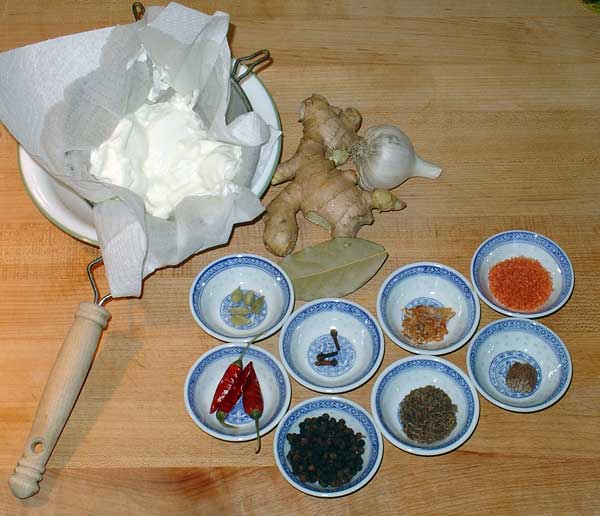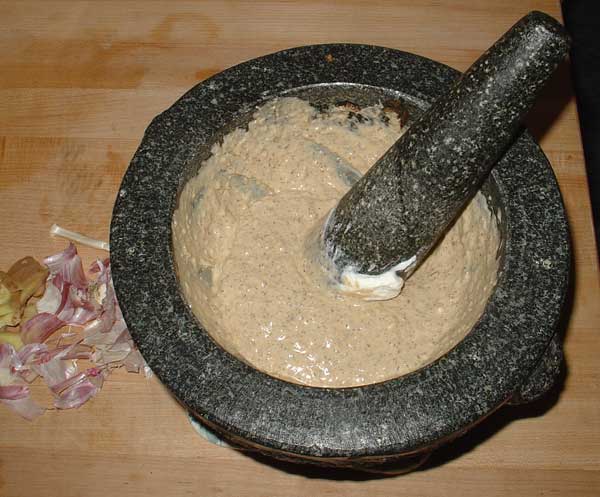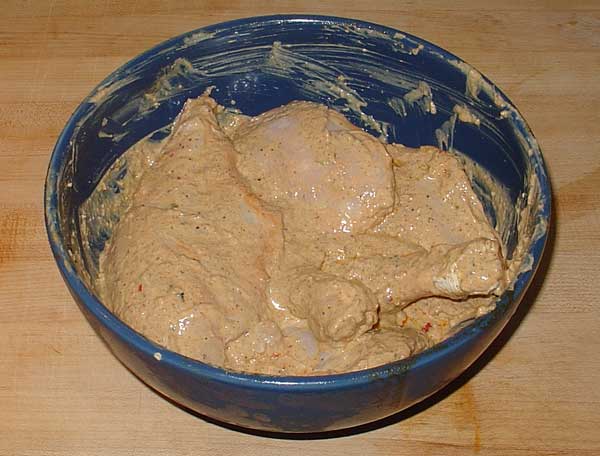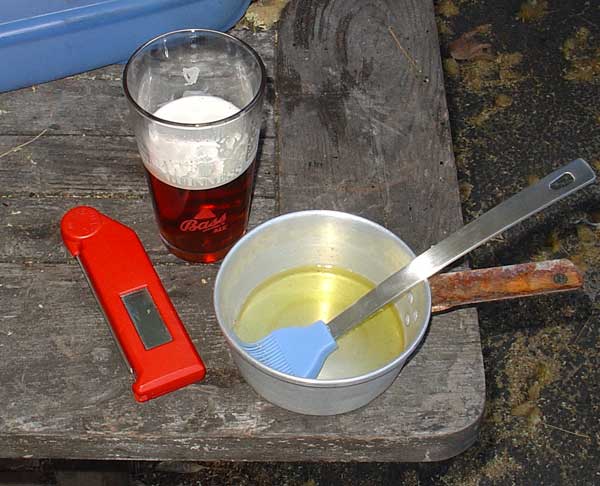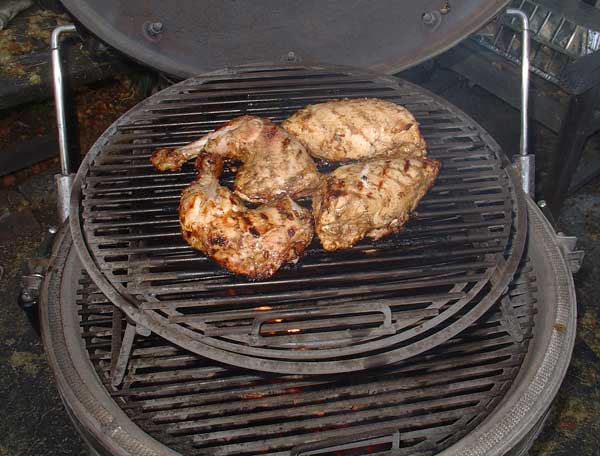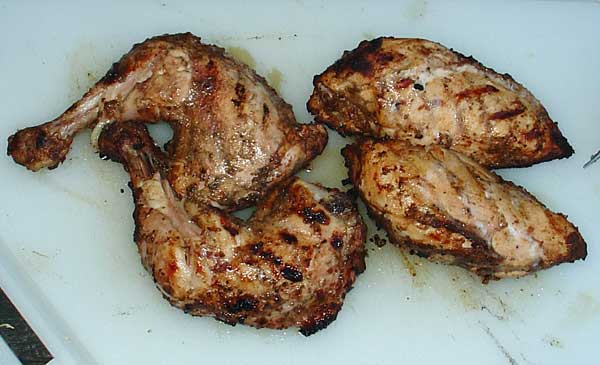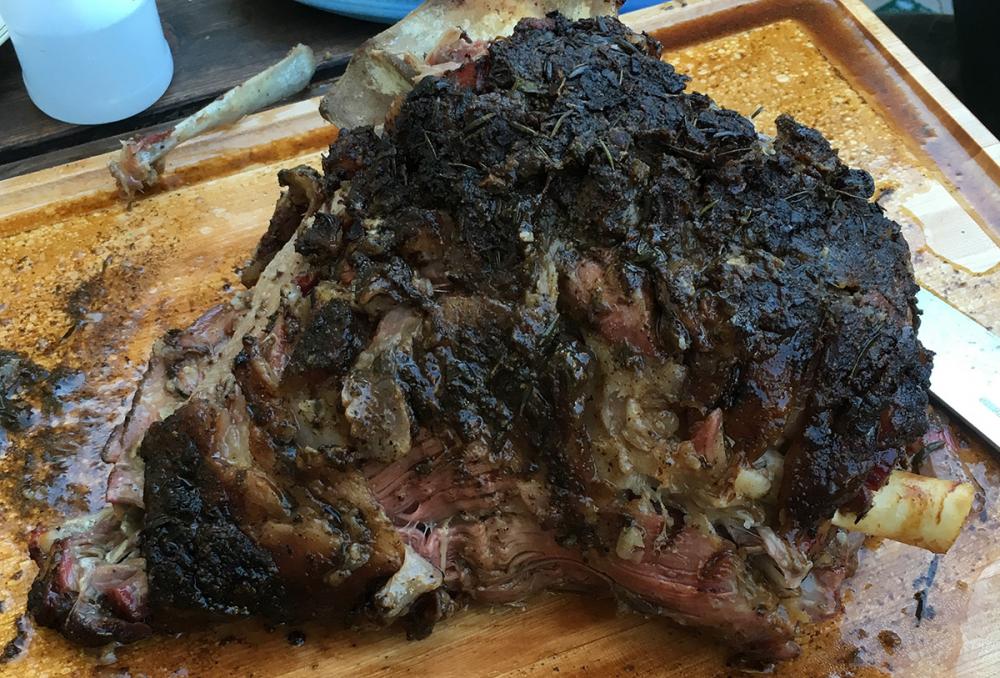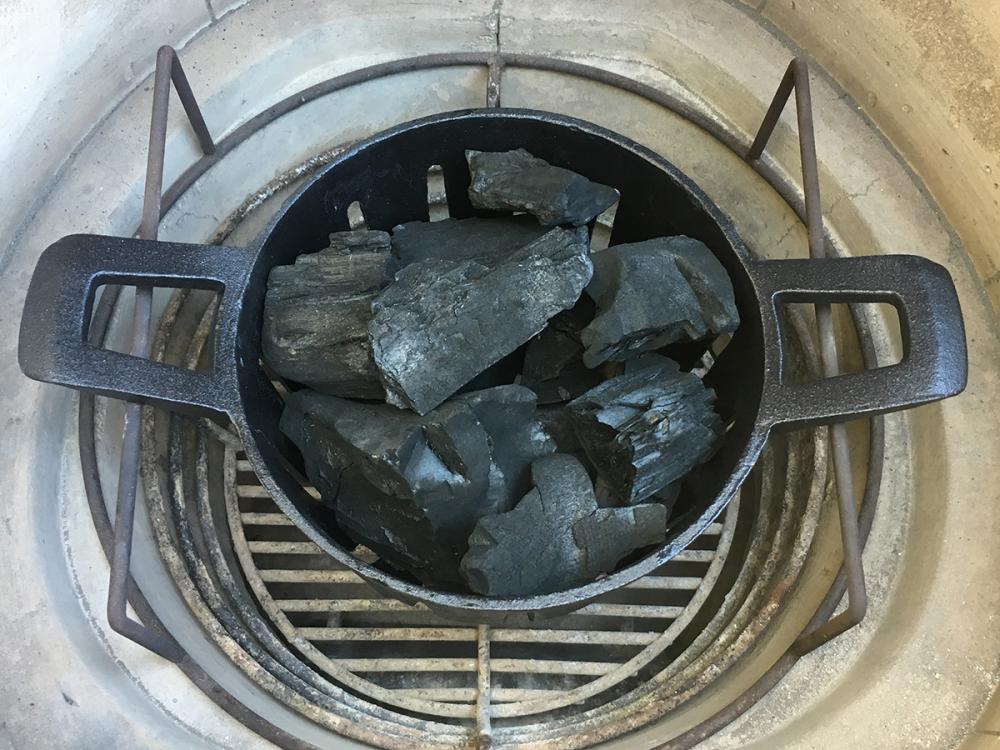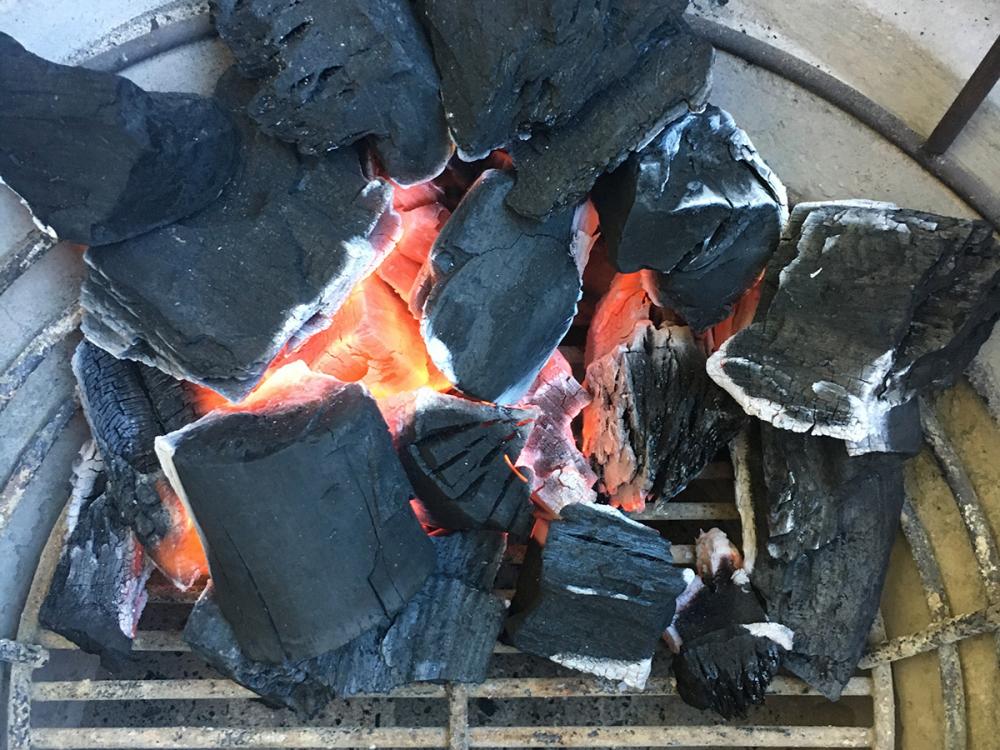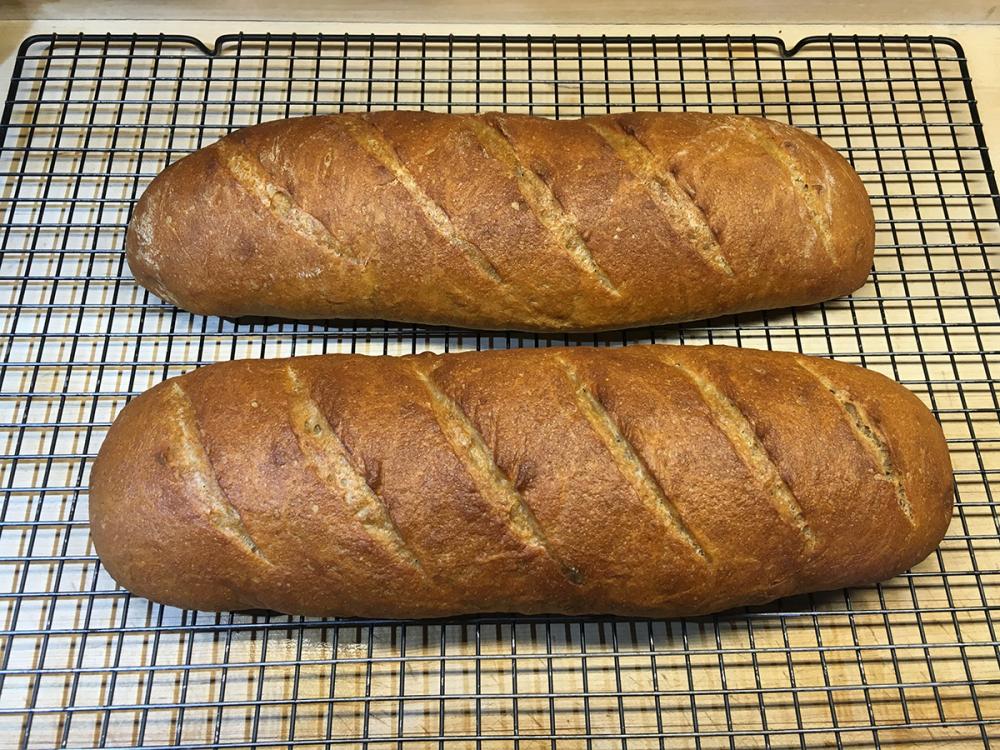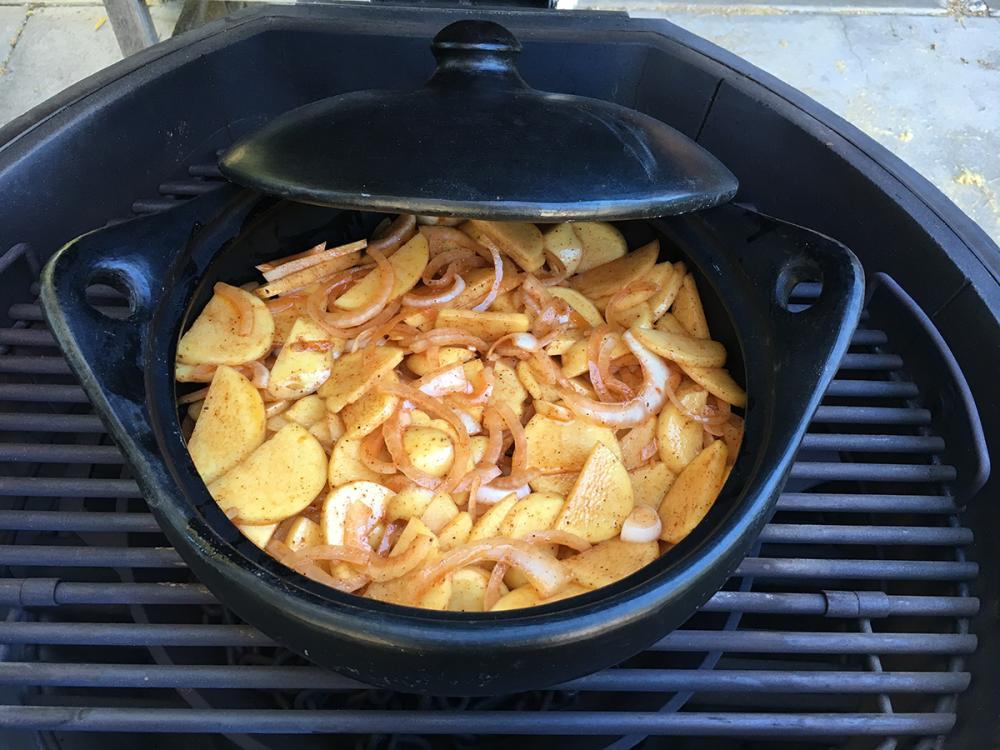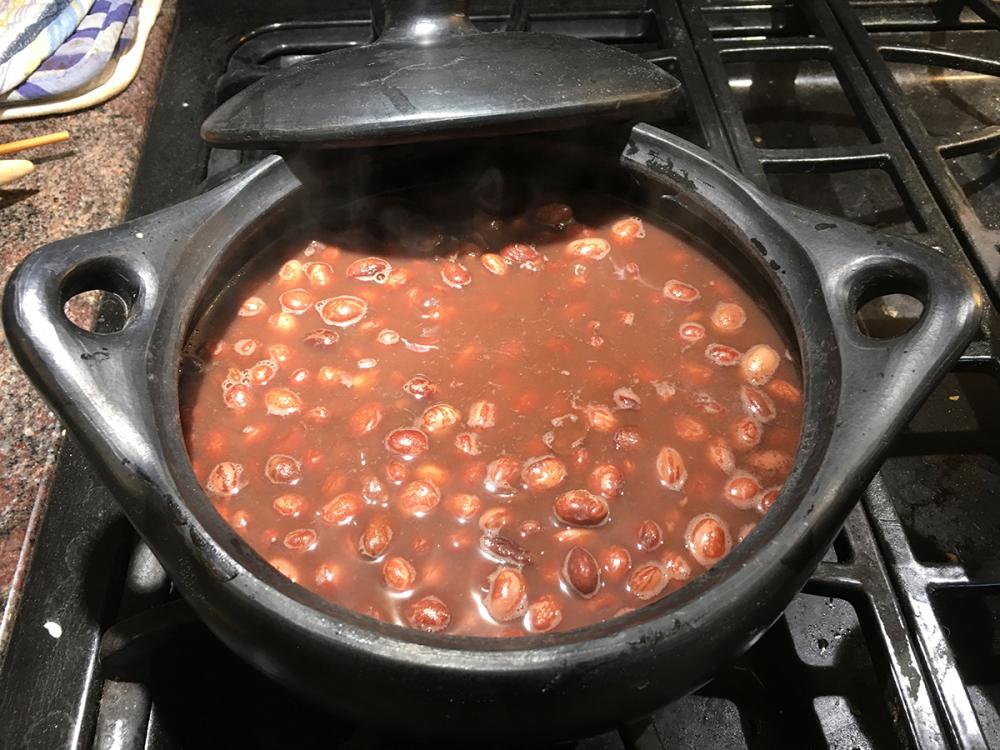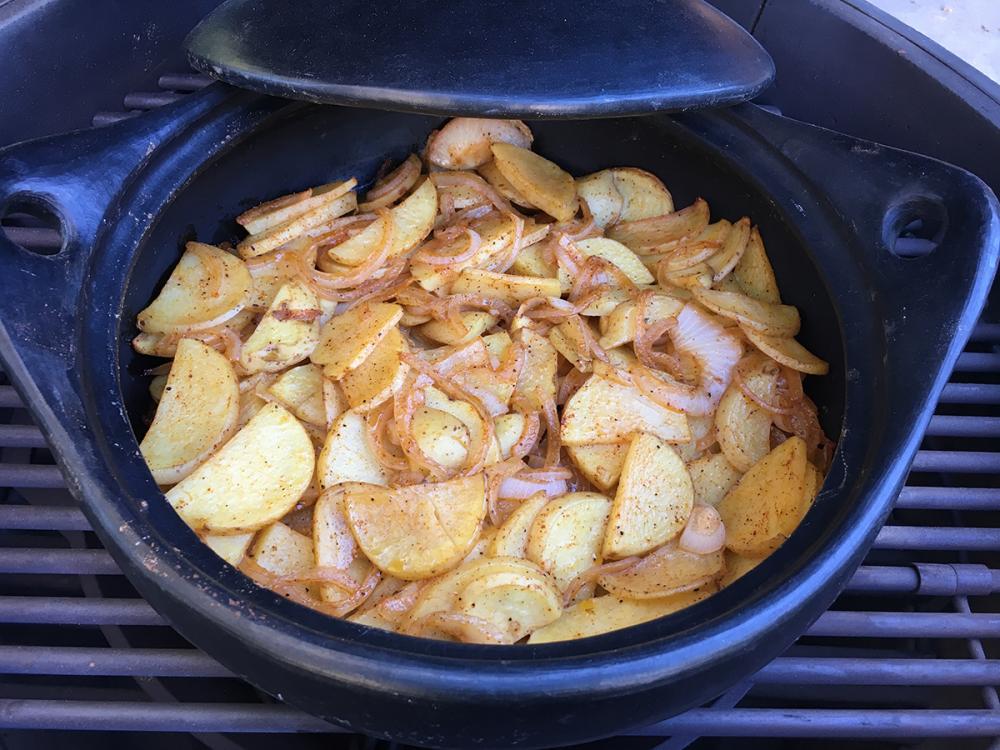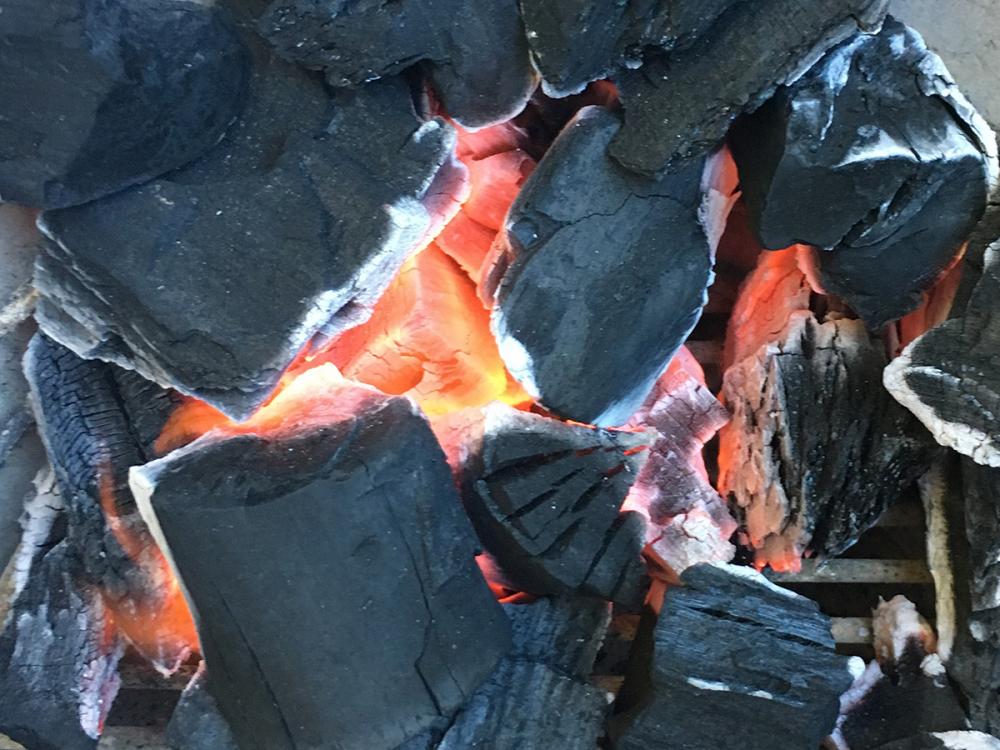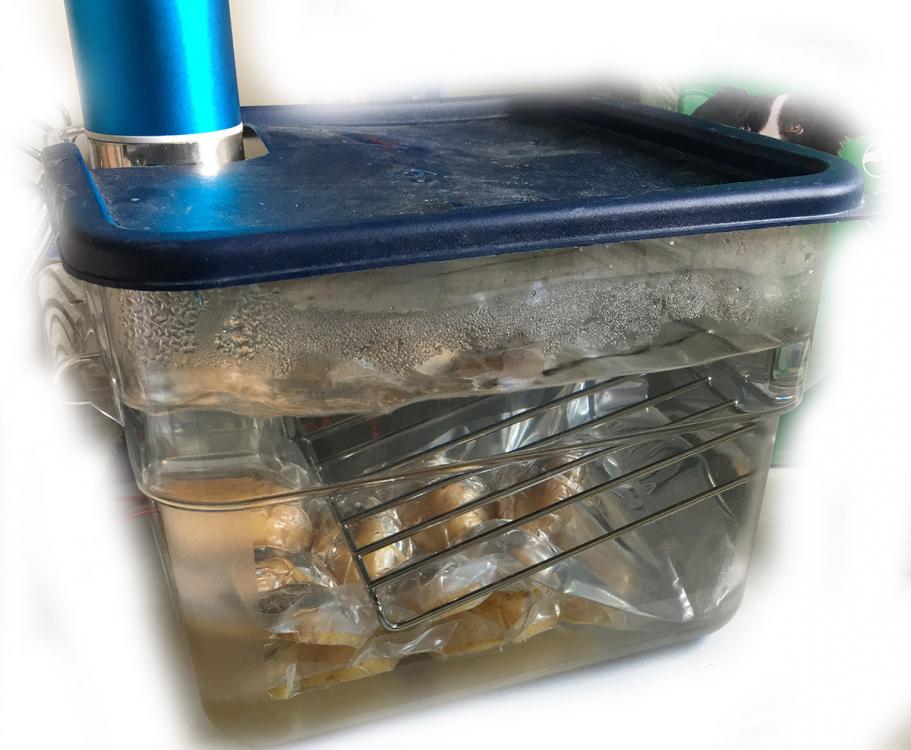-
Posts
1,738 -
Joined
-
Last visited
-
Days Won
53
Content Type
Profiles
Forums
Events
Everything posted by Syzygies
-
We grow Genovese basil from seed for pesto, first batch tomorrow with guests. This is further than I usually let it go, perhaps 5" high each. One of two barrels. An automatic irrigation system is a must (we use Hydrawise) as these seeds need watering multiple times per day. My first trip to Italy, half a lifetime ago, friends in Genova 'educated' me by showing me the basil sold at market. Rather small bunches. They characterized United States basil as lawn clippings, the primary reason that United States pesto was ghastly, inedible. They were very sweet about this, but this was a fervently held belief. English to english translation: We were morons to grow our basil so big, as if we preferred eating six year old sheep. On the other hand, I specifically seek out large weedy basil as a bed on which to cook salmon, which will be our second course tomorrow: Brine the best wild salmon you can find, 1/2 cup salt per gallon, less sugar, four hours. Place on a bed of weed basil in a Spanish cazuela, smoke gently using apple wood till melting. To die for.
-

Best vacuum packer? (FoodSaver alternatives?)
Syzygies replied to Syzygies's topic in Relevant Product Reviews
Mine is on a counter in the next room. Easier to move the food! We use the dining room table for staging. -
That is the key. I pushed a bit to get the POSK. Laurie bought me the KK. (Her favorite part was talking with Dennis.) Don't emphasize price. Try different techniques, and ask attentively what you should do the same, or different. She'll lead you. I'm pretty much under orders to only use coconut extruded lump and my smoke pot for low & slows. And we're eagerly phasing out ordinary charcoal for high temp chicken, now that we have coffee lump. We're not affluent, but we can afford what we want, and food matters. The problem with more charcoal is finding space to store it.
-
Yeah, I was just struck by the alliteration, baking steel at bakingsteel dot com, baking stone at baking stone dot come. So I kept going...
-
I have three baking steels from http://www.bakingsteel.com/, several baking stones from https://bakingstone.com/, a baking bong from http://www.bakingbong.com, and a KK baking stone. These are spread over two coasts and friend's kitchens. For bread, I tried a rectangular kiln shelf, but it had the wrong thermal properties. I had a baking stone cut to match, and I now stack them in my KK for bread. For pizza, I prefer a baking steel. It's hard to make apples-to-apples comparisons here, as one adapts to each stone. From a reclusive childhood playing chess with myself, I've learned to be fair, giving each option a chance. The technique nevertheless needs to adapt to the stone.
-
That is absolutely a Kamado from Richard, perhaps Sacramento. My first Kamado looked like this, till the tiles fell off. The less you know about its provenance (cough! cough!), or its common acronym (POSK) the better. It is cheaply made, but worth rescuing if there are no major cracks. Take apart the top hat, buy matching stainless steel bolts and nuts, and use them to retrain, clean and (food-safe) oil the threads, or you'll lose the top hat when it gets stuck. I could have bought an early KK instead of that Kamado. I mistook the KK for a copy, a Manfred Mann version of Quinn the Eskimo, even though Dylan's original was wretched. As I understood it, some workers at the prosperous teak flooring enterprise that Dennis owns in Bali came to him, some lowlife had abandoned the workers at a tiny ceramic cooker factory down the street, when said lowlife got into some sort of trouble. Relocate, a lifelong pattern. Dennis said hey, that sounds cool, took over the factory so the workers could continue feeding their families, and got very interested in redesigning the cookers. This is at least the KK origin myth that some of us understand. The part I'm sure of is that Dennis is a very good person. I know far more than I wish I did about restoring said Kamado, ask questions as you proceed. People make old cars into barbecue pits, you can certainly contain a fire in this artifact. If you value your time, buy a Komodo Kamado.
-
I restored the lost pictures for my tandoori chicken recipe, an ancient post (look at my primitive cooker): Tandoori Chicken
-
I use a baking steel for pizza at around 600 F; I believe that you'll be happy. Consider the upper deck, to get as much radiant heat as possible on the pizza top. None of my baking steels have grease troughs; I believe that this is called free soloing. I've never had a problem, but I always have to check the bottom after a friend uses one.
-
Incomplete combustion is bad with raw fuel, not so bad with beautiful embers. Try it! This is an empirical question, and I certainly lurched at my share of mirage windmills my first years doing this. The practical problems are finding a protocol that isn't too much trouble, and avoiding a runaway fire. If you get the KK too hot you're not easily going back.
-
I'd never tried a whole lamb shoulder before, so when Berkeley Bowl offered me a 9 pound lamb shoulder for $50, it was hard to say no. Have the neighbors over. A bit rich for the oppressive heat, but tasty. This called for Mediterranean rather than classic barbecue flavors, so the rub was a marinade of 1% salt (by weight of the shoulder), black pepper, smashed garlic cloves, lemon peels, rosemary, olive oil. The oil tends to suspend the salt and impede absorption into the meat, so better technique might be to lead with the salt, and apply the marinade later. Multiple sources propose four hours at 325 F, for smaller shoulders. I used pink butcher paper in the style of Franklin Barbecue for the last hour, which turned into two with late arriving guests. Incredibly moist. Or is that sensation fat? A great change of pace, but this doesn't edge out pork butt, where the fat is easier to manage. Working over the leftovers for hash will be like dealing with a bone-riddled fish. I'll vacuum pack as-is, and pick over after warming sous vide.
-
Ding, ding ding! We have a winner! Um, yeah. If this is your second post, I can't wait to read #100. One of my favorite barbecue books is Legends of Texas Barbecue Cookbook by Robb Walsh. Not for the recipes, though one reads them and gets the idea. Rather, they're anti-recipes, to counterbalance the idea of saucing inedibly cheap ribs with some concoction made from raspberry jam and eleven other processed foods from the aisles of the supermarket where I get lost (one Apollo 11 astronaut "never trained in the LEM"). Texas butchers sold the parts of the animal that didn't fetch a premium, out the back door on butcher paper to area workers, precooked. As in, over fire with salt, pepper, and smoke. I oversimplify, as the other point of this book, actually a history, is that there are no rules. Franklin Barbecue: A Meat-Smoking Manifesto cooks everything 275 F (in a salvaged 1000 gallon propane tank you modified to a cooker using "basic metal-working skills") because they're running a restaurant, and more than one cooker temperature would be impractical. Mulitple stories in Legends describes the morning cook salvaging and rebuilding the fire, because that's how their setup works. In any case, ceramic cookers are a modern aberration of traditional barbecue technique. Setting aside the expert question of green woods, traditional barbecue was cooked using mature wood embers. One had a second fire, for preparing said embers, to avoid the nasties of initial combustion reaching the food. Charcoal is an incomplete conversion of wood to a neutral fuel. Not all charcoal is equal. Anything Dennis sells is spectacular; if you're younger than Dennis and can come up with the scratch, consider building a shed to store a lifetime supply of his charcoal. Japanese binchu is the diamond grade generic charcoal, though pricey. One can use it as artist charcoal, and the Japanese cook with binchu indoors. The Lump Charcoal Database is a comprehensive review site, although I don't find it practical: If I'm going to ship charcoal I'll buy from Dennis, and what I can find locally is hit or miss. One can also make charcoal; I discovered the idea of a "smoke pot" (drill three 1/8" holes in the bottom of a one or two quart cast iron Dutch oven, fill with smoking wood chips or chunks, seal the lid on with floor paste, and nestle into a low & slow fire for clean smoke with no nasties) while experimenting with making my own charcoal. This isn't practical. I'm now in a regime where I use three classes of charcoal: Extruded coconut (Dennis) for low & slow along with a smoke pot, Coffee lump (Dennis) for somewhat higher temperatures and direct grilling, and hardwood briquets (Lazzari; their warehouse is nearby) for ample fuel for high cooks such as bread and pizza. I could do without the Lazzari charcoal if I could find space to make standardizing on the coffee charcoal practical, and I'm very careful to burn Lazzari charcoal to embers before exposing food to the fire. One could use coffee lump for everything; extruded coconut is not the only class of charcoal that can burn cleanly "like a fuse" with raw charcoal in proximity to the active fire, yet no off flavors. Binchu also fits this bill, so one can keep exploring. I'll keep using my hoard of extruded coconut (some predates Dennis) because I have it, but if I won a pallet of coffee charcoal in a contest I'd probably not look further in that case either. But yes, the wrong charcoal doesn't smolder well for low & slow, and that's the Achilles heel of ceramic low & slow cooking. Dennis makes by far the best ceramic cooker, but he can't eliminate the problem. So instead he also makes charcoal.
-
By temperament it bothers me deeply that so many of our fellow creatures have two eyes, a nose and a mouth. We're all cribbing the same arbitrary code. What's wonderful about mathematics is waking up to a new universe each morning. My first memory of school was a student teacher stepping before my kindergarten class for the first time, tentatively leading us in a game of Simon Says. I got half the class to play backwards, and she left the room in tears. This is how I'm wired. Dennis isn't exactly the temperament to leave any solution alone, which is why the KK is so wonderful. One mode of problem solving is to maintain an acute awareness of all anomalies. (This is one theme of Thomas Kuhn's The Structure of Scientific Revolutions.) I do own a small Weber charcoal grill, and I'm sometimes tempted to fire it up. I always use the KK instead (it's tidier, for one, and any fire is more surely contained) but the geometry is different. I recall vividly roadside chicken in Thailand, grilled on rather primitive setups, but with very attentive charcoal handling, and a close distance between the coals and the birds. I used a similar rental setup, much larger scale, to grill many chickens for a wedding. The birds were supposed to be a throw away item, for kids who wouldn't eat steak, but they were the hit of the meal, and I'm still trying to sort out why. This is an anomaly. I miss that chicken. I love the chicken I make on the KK, but it isn't that chicken, and I still can't figure out how to make that chicken. Insuring that all airflow in a KK passes through the charcoal is an interesting issue I hadn't considered. For most scenarios, this together with great insulation is responsible for the unusual efficiency of a KK. However, a small fire isn't "most scenarios", and a small fire down in a split basket is pretty far away, even from the lower grate. I'm very tempted by the KK Charcoal Basket Splitter ($128); it will pay for itself, making more efficient use of charcoal lump in roasting scenarios. For "spot grilling" like blackening two red bell peppers for a Spanish dish, I'm going to build the smallest viable fire, and I want it mere inches away from my lower grill. The $40 Broil King is ideal for such moments. If I do go to a local metal shop to cut some steel plate, what I probably want is a plate that replaces the lower grill, with a hole that holds the KK charcoal basket. For those times when one wants a closer, perhaps smaller fire. After all, why not take advantage of the KK equipment; this problem already has a solution! I suppose I should have just said this is an empirical question.
-
I could get a prototype cut at a metal shop in my area. On one hand, I'm not a diehard fan of the hardest sear possible, finishing sous vide meat. A longer, slower finish imparts a different, gentler kiss of the fire. And 3" away I worry I'll get plenty of heat no matter what I do. On the other hand, suppose one wants to briefly use the KK as a 400 F oven? Sealing the airflow around this cast iron basket would consume the fuel more quickly and efficiently. One bonus, picking up charcoal from Bruce Pearson, was seeing his new 32" KK. I admired how the charcoal basket splitter worked, sealing off airflow away from the part basket. I can see how a splitter could be handy for my 23" KK.
-
For U.S. orders, Amazon is out of stock but Lowes has stock: Broil King KA5565 (Lowes) Broil King KA5565 (Amazon)
-
The coffee lump charcoal from Dennis is amazing. As soon as I got it home I made a small test fire for grilling a steak. If one thrills to fire, this charcoal is irresistible. One will look for excuses to play with it. I ordered a Broil King KA5565 Charcoal Caddie Basket to cradle a smaller, higher fire, and it came today. In my 23" KK it rests on the charcoal basket, with its rim about 3" below the lower grill grate. It has a capacity of about two quarts. Shown, I filled it with less than two pounds of coffee lump, about $2.50 USD at the scale we ordered. The KK is so well insulated, this will easily maintain roasting temperatures for several hours. I'm looking forward to quick fires to prepare single ingredients, such as grilled eggplants or peppers, or to grill a single piece of meat. With this charcoal basket, my KK will be my grill of choice for any scale. And coffee lump will be my fuel of choice.
-

Best vacuum packer? (FoodSaver alternatives?)
Syzygies replied to Syzygies's topic in Relevant Product Reviews
25% off VP210 and VP215, through Saturday, June 25, 2016, 11:59PM PST. (I'm just a happy customer on their mailing list.) VacMaster Sale Products -
Always have a plan for the after-party. One favorite of mine is from some Spanish cookbook, three pounds of potatoes, an onion, a teaspoon each of salt, black pepper, pimenton, and olive oil to mix. Roast to taste. The cookware is a La Chamba clay pot from Colombia. My friends and I have many sizes. These are twice as good as the next best option for clay cookware, and this is coming from someone with a serious problem with accumulating cooking equipment; I've probably tried your favorite, if this isn't it. They feel like very dense wood, are so buffered that stove-top cooking behaves like oven cooking, and I've never managed to break one. They're made from micaceous clay; one hears accounts of potters desperate to break their mistakes with similar clay, and all hurling pots like this does is damage the floor. They easily take direct flame. I own some beautiful tagines that collect dust because of La Chamba. They're the dream stove-top bean pot, worth it for this if they never see another use. Good Mother Stallard beans from Rancho Gordo, inside while I cooked outside on the KK.
-
My guess is to continue using CoCoChar for low and slow. This CoffeeChar lump is for directly experiencing fire, for anyone who thrills to fire. I just ordered a Broil King KA5565 Charcoal Caddie Basket for lifting and cradling smaller lump charcoal fires. For example to finish a sous vide steak. I'll review this after playing with it. There are many alternative charcoal splitters; Dennis makes one that blocks the airflow on the unused side.
-
The coffee lump charcoal from Dennis is amazing. Think Japanese Binchō-tan, scaled for the KK. Seeing this charcoal first hand is dangerous information.
-

New KK order - any must have accessories?
Syzygies replied to _Ed_'s topic in KK Pre-Sales Questions
I've been doing this a long time. What do I actually use, some or all of the time? A second charcoal basket, to save extruded coconut charcoal between low & slow cooks, while I use lump charcoal for high temp cooks. A terra cotta plant saucer for storing the spare basket, to contain ashes. (If one can afford to do so, one could simply use charcoal from KK for everything. We've thought about it, even 500 F chicken tastes better over charcoal from Dennis.) A basket splitter, to make more efficient use of good lump charcoal for small cooks. The splitter constrains the airflow to pass through the fire, even for a small fire. A cover. It rains here part of the year, and this keeps moisture out. Two long neck "weed burner" propane torches, with hose clamps added on the neck so that they balance on the rim of the KK, for lighting fires. A paint brush and a soft cloth dust mask for removing ash. A plastic painter's pan to set below the ash door, for collecting the ash as one brushes it out. This lives in the most recent empty charcoal bag converted to ash storage. Obviously, cold ashes only. Silicone heat resistant gloves. And other gloves, but these take the most heat. There are many options. A 3/8" wrench for scraping grill grates. Get one with the correct round to match the grate. (This is radically better than grill floss or countless other options. Anyone in a reasonable state of mental health will tell you that they're happy with the best solution they've found so far for a problem. Only trust comparisons, when someone has alternated between the two best candidates long enough to break their prejudices.) A metal water heater pan, some improvised way to plug the hole (figure this out at the store), and heavy duty scrubbies from the painting aisle (these blow away anything for the kitchen) for soaking and cleaning grills. (I'll sometimes trust a high heat cook instead, after a good wrench scraping.) I happen to have an electric pressure washer, for deck maintenance. After large low & slows (feeding 60 with pulled pork or brisket) it does a wonderful job of cleaning all grates (again, in the water heater pan). A paella pan, to use as heat deflector and drip pan. Line with foil for easy cleanup. (An official KK drip pan looks worth it to me; it will likely be my next purchase.) Two bath towels, and a cooler, for resting and transporting monumental meats. Heavy duty aluminum foil, for lining the plant saucer (easy disposal once the fat cools) and for wrapping monumental meats to rest in a cooler. Pink butcher paper, for following Austin Franklin barbecue technique. (The white is no better than aluminum foil; the pink breathes.) The official KK pizza stone, for bread or pizza. (I used to use a custom rectangular FibraMent-D baking stone, for two loaves of bread. Dennis got the pizza stone right, and I no longer use anything else.) A Baking Steel, for burgers or Japanese or Spanish griddle technique. The 15" by 1/4" round also fits an indoor oven and can be lifted by anyone. A 16" by 1/2" can be custom ordered, for more thermal punch. A Steam Pan, as described in KK as Steam Oven for Bread. A giant cast iron frying pan with the handle sawed off, filled with two spools of stainless steel chain, to go on the lower rack for bread cooks. (A KK single bottom drip pan would work here without rusting. Buy two, or keep moving the chain as needed.) Freeze 350g of ice in ziplock or vacuum seal bags, and slide the ice in to generate (after a delay making it possible to close the lid safely) enough steam to replicate a commercial bread oven. This is detailed in Keller's Bouchon Bakery but not original to them. This is superior to baking bread in a Dutch oven. Keller took much flack for this on other forums, from fools with zero understanding of physics who think that 10g of water from a plant spritzer suffices. A Smoke Pot, as described in A Dutch Oven Smoke Pot. Find a one or two quart cast iron Dutch oven, drill three 1/8" holes in the bottom, add smoking wood, and seal the lid on with flour paste. Nestle in with the charcoal, and heat it as much as possible while torch lighting the fuel directly under the pot. For low & slow cooks this controls smoke, avoiding nasty combustion byproducts; above 300 F even smoke from such a pot will taste as nasty as open wood. Try this at your own risk, you may be ordered to never use smoke any other way. I'm planning to test an all metal Kleen Kanteen as an easier alternative; I haven't yet. (One needs to work through an obsession with excessive smoke, if one has had one's heart broken too often on the BBQ trail from restaurants with inadequate smoke. There's a sweet spot where smoke is one more flavor in balance; find it.) A DigiQ DX2 BBQ Guru setup, for absolute control of longer cooks. This is indeed optional but very nice; I went years without after my previous unit died of old age. Then I committed to some major cooks for parties where I needed to be sure. A KK is remarkably stable, but if one goes eight hours without checking it can find a new equilibrium as the fire evolves. A Solo Stove Campfire, as described in Solo Stove. It provides a nimble way to make small fires away from the KK. For example, I now use mine to preheat my smoke pot. The applications are endless, and it's fun to use. What have I tried and discarded or given away? A rotisserie. Have you tried cleaning one of these!? I have found ways I actively prefer for cooking anything on the KK that one might use a rotisserie to cook. Chicken, direct at 500 F over a nearly spent fire, and tend it a few times. (If you do have an electric pressure washer handy, then cleaning a rotisserie would not be an ordeal. I don't miss mine. It was fussy.) As a rule, avoid all aspirational purchases in life. There's only so much one needs to do before baby comes home, one can figure out the rest as one goes. Try life without a rotisserie, for example, and see if a BBQ Guru is indicated. -
I have a chamber vacuum machine in New York; we use a good clamp machine in California. The potatoes are vacuum sealed already cut up, and go cold into a cold bath, then SV 85 C for 75 minutes. 85 C is the threshold for cooking pretty much any vegetable. They don't overcook, and this process neither adds nor removes water. It's pretty much ideal, and I've tried everything over the years. In particular, steaming or boiling potatoes it's pretty easy to overshoot. And it's very easy to cool potatoes back down in an ice bath if they're vacuum sealed. Or one could plan ahead, and just throw the packets in the fridge or freezer. Twice cooked starch is a thing. It's the secret to french fries, for example.
-
Wow, that looks great! I use parchment paper whenever helpful without apology; my sourdough bread is about to start its bake on parchment paper. I used to use parchment paper religiously for pizza. If one works quickly, spreading semolina flour on one's work surface is less hassle than parchment paper. I've switched. Of course, your spectacular crust and crumb suggests a wetter dough? If you need parchment paper to pull this off, so be it!
-
Yes, two is easier. A sous vide precook for pan-fried potatoes is perhaps our overall favorite application. Tonight we're making hash with leftover steak. For one meal involving a very particular foodie, I sous vide precooked potatoes 75 minutes (60-90 ok) at 85 C. I then dried them several hours on a rack using a fan. I then pan fried them with attitude in ghee. This was over the top; one could skip the drying phase. My friend was dumbfounded; he kept staring at pieces of potato in disbelief.
-
We leave a 12 quart Cambro set up in the laundry room, corner cut from the lid for the Anova. One begins to find very pedestrian uses replacing the microwave, such as defrosting and cooking peas as a side for dinner. Or simply defrosting. Set the target temperature to 0 C, and a circulating water bath defrosts rapidly while keeping the food in question as cold as in the fridge. Our favorite approach to red meat has become a several hour bath at 136 F or so, followed by a much shorter "roasting" in the KK oven. Once one asks the question if one is just playing Simon Says in attempting a hard sear, we find we prefer this softer approach. (Everything in our chest freezer is vacuum-packed in sous vide bags.)
-
什麼威爾伯說!




